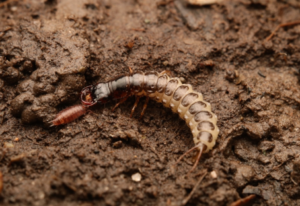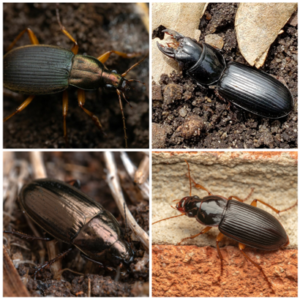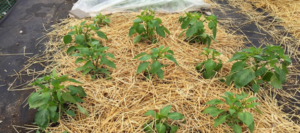Ground Beetles
Ground Beetles: How to Support These Garden Helpers During the Winter
Thanks to the University of Maryland/Maryland Grows this informative article on composting and climate change.
Do you ever wonder where insects go during the winter? This year, as you snuggle up under a warm blanket to escape the winter cold, think about how you can help the beneficial insects in your garden do the same. The harsh conditions of the cold season can be challenging to deal with. However, some insects can benefit from habitats that provide them with shelter not only during the winter but all year round. Ground beetles are a great example of insects that can be a tremendous help in the garden. They also appreciate a good nook or cranny to hide out in while the weather is less than ideal.
Ground beetles are one of the most diverse insect families in the world and can be found in many shapes and sizes across Maryland’s gardens, farms, and natural areas. Like butterflies and moths, ground beetles go through a complete metamorphosis, changing drastically in appearance throughout their life cycle. They begin their lives as larvae that resemble small, fast-moving, armor-plated caterpillars with giant mandibles – a little intimidating, but luckily, they’re on your side! The ground beetle larvae mostly feed on other small invertebrates, including a range of garden pests like aphids, grubs, and caterpillars. Ground beetles generally spend a few months as a larva and can live several more years as an adult.

Adult ground beetles can be anywhere from ⅛ to 1 ½ inches long and oval-shaped with a plain dark coloration, but some may sport a green or bronze iridescence. They have long legs and thread-like antennae. Like other beetles, they have hard wing covers, usually with prominent ridges running across their length. These wing covers protect hind wings that may sometimes be used to fly, but many species have lost this ability. Even those that retain it are more likely to be found running across the ground or burrowing down just underneath the substrate.
Ground beetles have large, powerful mandibles that they use to capture and chew their food, which they’re not picky about. They are well-known for eating a wide variety of foods, but many species have a preference for one type over another. Some species, including Chlaenius aestivus, Scarites subterraneus, and Poecilus chalcites are famous predators of other invertebrates including aphids, caterpillars, and slugs, and can help keep pests at bay in your garden. Other species such as Amara aenea, Harpalus pensylvanicus, and Anisodactylus sanctaecrucis also feed on other invertebrates, but have additionally been studied for their useful tendency to eat the seeds of common weeds, helping to manage these weeds before they even start growing.

While ground beetles do not damage garden plants, they may be considered a household pest if found wandering through homes. Most ground beetles are nocturnal and attracted to lights, so they may inadvertently enter houses and have trouble getting out. In this case, simply use a cup and a piece of paper or your hands to capture them. They do not pose any significant danger to you or your pets, but if handled roughly, their mandibles may deliver a small pinch. Relocate them outside where they can continue to serve you and your garden.
If you want to help support these useful critters, there are several actions you can take.
- Avoid practices that disturb soil fauna such as frequent tillage, and don’t use broad-spectrum insecticides, i.e. those that harm a wide range of insects including beneficials.
- Don’t leave the ground bare. Bare earth does not provide the best protection against the cold, so cutting back your plants before or during the winter to tidy up your garden actually may be harmful to resident ground beetles. Applying a straw mulch can help cover up bare earth and provide shelter for these overwintering insects. Planting perennials in or near your garden can also provide a lasting habitat for beneficial insects. Establishing stretches of perennial grasses called “beetle banks” is a common technique used to increase ground beetle numbers on farms in many places around the world.
- Create sheltered spaces. Ground beetles will even hide out underneath large stones, logs, or brush piles. In addition to helping ground beetles, creating sheltered habitats and leaving ground cover over the soil can also help other beneficial insects, including pollinators and insects that are important food for birds (“leave the leaves!”).

Because they can live for several years, helping ground beetles for one year can result in much greater numbers during the following years as well. It’s an investment in your garden’s natural defenses against pests! Having these predators around can help keep you from needing to resort to using pesticides which may be harmful to your health and to the environment. Next time you’re making plans for your garden, consider helping out your garden’s natural protectors and enjoy as they return the favor.
References
Dennis, P., Thomas, M. B., & Sotherton, N. W. (1994). Structural Features of Field Boundaries Which Influence the Overwintering Densities of Beneficial Arthropod Predators. The Journal of Applied Ecology, 31(2), 361. https://doi.org/10.2307/2404550
Jordan, S. F., Hopwood, J., & Morris, S. (2020). Nesting & Overwintering Habitat for Pollinators & Other Beneficial Insects. The Xerces Society for Invertebrate Conservation.
Lövei, G. L., & Sunderland, K. D. (1996). Ecology and Behavior of Ground Beetles (Coleoptera: Carabidae). Annual Review of Entomology, 41(1), 231–256. https://doi.org/10.1146/annurev.en.41.010196.001311
MacLeod, A., Wratten, S. D., Sotherton, N. W., & Thomas, M. B. (2004). “Beetle banks” as refuges for beneficial arthropods in farmland: Long-term changes in predator communities and habitat. Agricultural and Forest Entomology, 6(2), 147–154. https://doi.org/10.1111/j.1461-9563.2004.00215.x
Philpott, S. M., Albuquerque, S., Bichier, P., Cohen, H., Egerer, M. H., Kirk, C., & Will, K. W. (2019). Local and Landscape Drivers of Carabid Activity, Species Richness, and Traits in Urban Gardens in Coastal California. Insects, 10(4), Article 4. https://doi.org/10.3390/insects10040112
Philpott, S. M., & Bichier, P. (2017). Local and landscape drivers of predation services in urban gardens. Ecological Applications, 27(3), 966–976. https://doi.org/10.1002/eap.1500
By Alireza Shokoohi, M.S. Student, Department of Entomology, University of Maryland, College Park.
In addition, if you are looking to buy or sell your home (with or without a garden), contact Gigi today. Oh by the way, I’m never too busy for any of your referrals!






Recent Comments